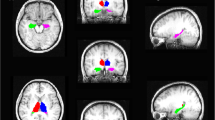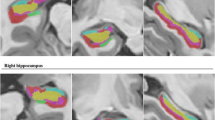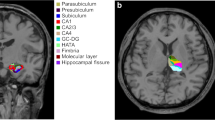Abstract
Purpose
The purpose of the study was to evaluate the effects of mesial temporal lobe epilepsy with hippocampal sclerosis (MTLE-HS) on corpus callosum (CC) morphometry in large and pathologically proven MTLE-HS patients.
Methods
We measured certain CC dimensions in 103 patients and 33 healthy controls using in vivo magnetic resonance imaging. In particular, we compared the two groups in relation to the clinical (localization of the HS, duration of epilepsy, frequency of seizures and length of seizures) and demographical (age, gender, handedness) features. Students’ t test, two-way ANOVA and Spearman test were used for statistical analysis.
Results
There was no significant difference between CC morphometry with respect to age and handedness among patients. The differences between the genders, however, were significant favouring longer diameters in males. We found significant decrease in the dimensions of the genu, body, isthmus and splenium of the CC in the MTLE-HS group, but there was no reduction in the size of the rostrum.
Conclusions
This general reduction in the size of the CC except for the rostrum was thought to be the result of cortical atrophy secondary to the disease. Concerning the preserved rostral part of the CC, it was thought that the fibers of the frontal lobe pass through different pathways than the tracts in the rostrum.


Similar content being viewed by others
References
Clarke S, Kraftsik R, Innocenti GM, Van Der Loos H (1986) Sexual dimorphism and development of the human corpus callosum. Neurosci Lett Suppl 26:299
Dabbs K, Jones J, Seidenberg M, Hermann B (2009) Neuroanatomical correlates of cognitive phenotypes in temporal lobe epilepsy. Epilepsy Behav 15:445–451
De Lacoste MC, Kirkpatrick JB, Ross ED (1985) Topography of the human corpus callosum. J Neuropathol Exp Neurol 44:578–591
Demeter S, Ringo JL, Doty RW (1988) Morphometric analysis of the human corpus callosum and anterior commissure. Hum Neurobiol 6:219–226
(2008) Engel J, Pedley TA (ed) Epilepsy, a comprehensive textbook, 2nd edn. Wolters Kluwer, Lippincott Williams & Wilkins, Philadelphia, pp 2456–2467
Harris RM, Sundsten JW, Fischer-Wright RA (1987) The human corpus callosum: an MRI study varying sex, handedness and age. Soc For Neurosci Abstr 13:45
Helmsteadter C, Kockelmann E (2006) Cognitive outcomes in patients with chronic temporal lobe epilepsy. Epilepsia 47:96–98
Hermann B, Seidenberg M, Bell B, Rutecki P, Sheth RD, Ruggles K, Wendt G, O’Leary D, Magnotta V (2002) The neurodevelopmental impact of childhood-onset temporal lobe epilepsy on brain structure and function. Epilepsia 43(9):1062–1071
Hermann B, Hansen R, Seidenberg M, Magnotta V, O’Leary D (2003) Neurodevelopmental vulnerability of the human corpus callosum to childhood onset localization-related epilepsy. Neuroimage 18:284–292
Hermann B, Seidenberg M, Bell B, Rutecki P, Sheth RD, Wendt G, O’Leary D, Magnotta V (2003) Extra temporal quantitative MR volumetrics and neuropsychological status in temporal lobe epilepsy. J Int Neuropsychol Soc 9:353–362
Janszky J, Janszky I, Schulz R, Hoppe M, Behne F, Pannek HW, Ebner A (2005) Temporal lobe epilepsy with hippocampal sclerosis: predictors for long-term surgical outcome. Brain 128:395–404
Kertesz A, Polk M, Howell J, Black SE (1987) Cerebral dominance, sex and callosal size in MRI. Neurology 37:1385–1388
Kim H, Piao Z, Liu P, Bingaman W, Diehl B (2008) Secondary white matter degeneration of the corpus callosum in patients with intractable temporal lobe epilepsy: a diffusion tensor imaging study. Epilepsy Res 81:136–142
Lieb JP, Dasheiff RM, Engel J Jr (1991) Role of the frontal lobes in the propagation of mesial temporal seizures. Epilepsia 32:822–837
Luders E, Narr KL, Zaidel E, Thompson PM, Jancke L, Toga AW (2006) Parasagittal asymmetries of the corpus callosum. Cereb Cortex 16:346–354
McIntyre DC, Gilby K (2008) Mapping seizure pathways in the temporal lobe. Epilepsia 49:23–30
Napolitano CE, Orriols M (2008) Two types of remote propagation in mesial temporal epilepsy: analysis with scalp ictal EEG. J Clin Neurophysiol 25:69–76
Nasrallah HA, Andreasen NC, Coffman JA, Olson SC, Dunn VD, Ehrhardt JC, Chapman SM (1986) A controlled magnetic resonance imaging study of corpus callosum thickness in schizophrenia. Biol Psychiatr 21:274–282
O’Dwyer R, Wehner T, LaPresto E, Ping L, Tkach J, Noachtar S, Diehl B (2010) Differences in corpus callosum volume and diffusivity between temporal and frontal lobe epilepsy. Epilepsy Behav 19:376–382
Oyegbile TO, Bhattacharya A, Seidenberg M, Hermann BP (2006) Quantitative MRI biomarkers of cognitive morbidity in temporal lobe epilepsy. Epilepsia 47:143–152
Ozdemir ST, Ercan I, Sevinc O, Guney I, Ocakoglu G, Aslan E, Barut C (2007) Statistical shape analysis of differences in the shape of the corpus callosum between genders. Anat Rec 290:825–830
Ozturk AH, Tascioglu B, Aktekin M, Kurtoglu Z, Erden I (2002) Morphometric comparison of the human corpus callosum in professional musicians and non-musicians by using in vivo magnetic resonance imaging. J Neuroradiol 29:29–34
Pandya DN, Karol EA, Heilbron D (1971) The topographical distribution of interhemispheric projections in the corpus callosum of the rhesus monkey. Brain Res 32:31–43
Pujol J, Vendrell P, Junque C, Marti-Vitalta JL, Capdevila A (1993) When does human brain development end? Evidence of corpus callosum growth up to adulthood. Ann Neurol 34:71–75
Pulsipher DT, Seidenberg M, Morton JJ, Geary E, Parrish J, Hermann B (2007) MRI volume loss of subcortical structures in unilateral temporal lobe epilepsy. Epilepsy Behav 11:442–449
Standring S (ed) (2008) Gray’s Anatomy, The anatomical basis of clinical practice, 40th edn. Churchill Livingstone Elsevier, London, pp 354–356
Szabo CA, Lancester JL, Lee S, Xiong JH, Cook C, Mayes BN, Fox PT (2006) MR imaging volumetry of subcortical structures and cerebellar hemispheres in temporal lobe epilepsy. Am J Neuroradiol 27:2155–2160
Weber G, Weis S (1986) Morphometric analysis of the human corpus callosum fails to reveal sex-related differences. J für Hirnforsch 27:237–240
Weber B, Luders E, Faber J, Richter S, Quesada CM, Urbach H, Thompson PM, Toga AW, Elger CE, Helmsteadter C (2007) Distinct regional atrophy in the corpus callosum of patients with temporal lobe epilepsy. Brain 130:3149–3154
Witelson SF (1989) Hand and sex differences in the isthmus and genu of the human corpus callosum. Brain 112:799–835
Yoshii F, Barker W, Apicella A, Chang J, Sheldon J, Duara R (1986) Measurements of the corpus callosum (CC) on magnetic resonance (MR) scans: effects of age, sex, handedness and disease. Neurol 36(Supplement 1):33
Zarei M, Johansen-Berg H, Smith S, Ciccarelli O, Thompson AJ, Matthews PM (2006) Functional anatomy of interhemispheric cortical connections in the human brain. J Anat 209:311–320
Conflict of interest
The authors declare that they have no conflict of interest.
Author information
Authors and Affiliations
Corresponding author
Rights and permissions
About this article
Cite this article
Firat, A., Tascioglu, A.B., Demiryurek, M.D. et al. Evaluation of corpus callosum morphometry in patients with mesial temporal lobe epilepsy with hippocampal sclerosis. Surg Radiol Anat 36, 47–54 (2014). https://doi.org/10.1007/s00276-013-1144-y
Received:
Accepted:
Published:
Issue Date:
DOI: https://doi.org/10.1007/s00276-013-1144-y




